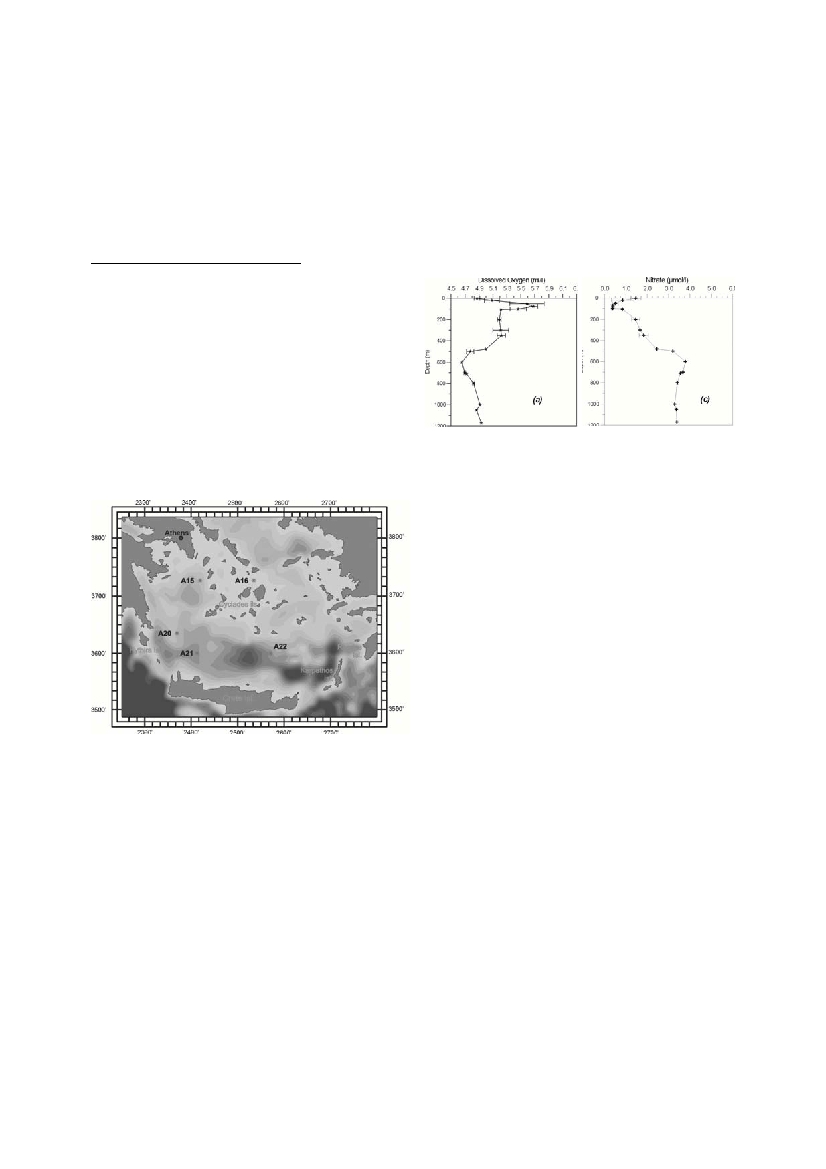Rapp. Comm. int. Mer Médit., 36,2001
61
Introduction
The southern Aegean Sea is one of the most oligotrophic sub-basins of
the Mediterranean Sea. It is noticeable that nutrient concentrations in the
Aegean Sea are twelve times lower than in Atlantic Ocean and three times
lower than in Ionian Sea. In the framework of several international pro-
grams during the last years (e.
g.P
O
E
M
, P
O
E
M
BC, P
E
L
AG
O
S
/
M
T
P
-
I
,
M
E
D
/
P
O
L
–
A
egean Sea), a number of studies have dealt with the Southern
A
egean Sea (Cretan Sea) and the straits of the Cretan Arc [1,2,3].
This paper aims to record the dissolved oxygen and nutrient distribu-
tions in the south Aegean sea and the organic contend in the sediments as
well as to compare with data from previous studies.
Materials and Methods
Seawater and surface sediment samples (0-3 cm) were collected at five
stations in the Aegean Sea, with the oceanographic vessel “Aegeo” (fig. 1).
DO measurements were performed on the oceanographic vessel “Aegeo”
using the Winkler method [4]. Phosphate were also measured on board
with a Perkin-Elmer UV/VIS (Lambda 2S) spectrophotometer using stan-
dard method [5], whereas silicate, nitrate and nitrite were measured with a
RAN+LUEBBE autoanalyzer according to standard methods [6,7].
Results and discussion
In the upper layer (up to 100m) of the south Aegean Sea, the tempera-
ture, salinity and density values ranged as follows: temperature: 15.09-
24.65°C, salinity: 37.84-39.18 psu and density: 25.91-28.93. In the deep
layer (100m-bottom) the respective temperature, salinity and density vari-
ations recorded as follows: temperature: 14.24-15.67°C, salinity: 38.86-
39.04 psu and density: 28.82-29.26.
DO concentrations at the surface do not exceed 4.9 ml/l, diminishing
with depth below 75 m. Below 400m strong negative gradient of DO con-
centration is observed, associated with the presence of Tr
a
n
s
i
t
i
o
n
a
l
MediterraneanWater (TMW) in the intermediate layer (500-700m), which
is a rather “old” water mass [2]. The deeper (>700m) layers of the Cretan
sea are well-oxygenated (4.93 ml/l at 1170m), identifying the presence of
the Cretan Dense Water (CDW), which is relatively “young” water mass.
Nutrient distribution shows enrichment in reactive phosphate, nitrate and
silica below 200m, which rises progressively with depth (figs.1, 2). T
h
e
TMW layer of the Cretan Sea is characterized by the maximum nutrient
concentrations associated with the biochemical processes (oxidation, reg
e
n-
eration) that occur in this layer. The TMW layer is a “nutrient-rich and oxy-
gen- poor” water mass. The nutrient concentrations recorded in the inter-
mediate layer of the Cretan Sea, are within the same range of values report-
ed after 94-95, and much higher than those measured during 1980-90 [8].
Total carbon content in sediments ranged between 7.1 to 9.3. The ratio
organic carbon to nitrogen is rather high according to the Redfield value
and ranged between 9.0-11.6, indicating that surficial sediments are rela-
tively impoverished in nitrogen, possibly due to the oligotrophic character
of the study area and/or to the higher turnover rate of nitrogen relative to
carbon. The C:N ratio of these Southern Aegean sediments is comparable
with the recently reported values for sediments from the northern Aegean
Sea.
Conclusions
Minimum values of dissolved oxygen and maximum of nutrients were
observed at the TMW layer, whereas the higher oxygen and lower nutrient
content observed in the deep layer of the South Aegean is related to the
presence of the Cretan Dense Water (CDW).
The nutrient concentrations recorded in the intermediate layer of the
Cretan Sea are within the same range of values reported after 94-95, and
much higher than those measured during 1980-90. The relative nitrogen
deficiency of the sediments defines the oligotrophic character of the
Aegean Sea.
References
1. Souvermezoglou, E., 1989. Distribution of nutrients and oxygen in the
Eastern Mediterranean Sea. Proceedings of the UNESCO/ IOC Second
ScientificWorkshop,Trieste, Italy, POEM Sci. Repts. 3, Cambridge,
Massachusetts, USA, 85-102.
2. Krasakopoulou, E., Souvermezoglou, E., Pavlidou, A. and Kontoyiannis,
H., 1999. Oxygen and nutrients ?uxes through the Straits of the Cretan Arc
(March 1994 - January 1995). Progress in Oceanography, 44: 601-624.
3. Friligos, N. and Krasakopoulou, E., 1999. Chemical characteristics of the
seawater and the sediments in the Aegean Sea. 10th MESAEP Symposium,
Alicante - Spain 2-6 October 1999, II,10: 58
4. Carpenter J.H., 1965(b). The Chesapeake Bay Institute technique for dis-
solved oxygen method. Limnol. Ocean., 10 : 141-143.
5. Murphy J. and Riley J.P,. 1962 A modified single solution method for phos-
phate in natural waters. Anal. Chim. Acta, 12: 162-176.
6.Mullin J.B. and Riley J.P., 1955. The colorimetric determination of silicate
with special reference to sea and natural waters. Anal. Chim. Acta, 12: 162-
176.
7. Strickland J.D.H, and Parsons T.R., 1968 A practical handbook of sea water
analysis.Bull. Fish. Res.Bd. Canada, 167: 310p.
8.Souvermezoglou, E., Krasakopoulou, E.,2000. Chemical Oceanography in
the Cretan Sea: Changes associated to the Transient.Mediterranean Marine
Science, 1/2, 91-103.
PHYSICO-CHEMICAL PARAMETERS IN SEAWATER AND SEDIMENT IN SOUTH AEGEAN SEA, JULY 2000
Friligos N*., Krasakopoulou E. and Pavlidou A.
National Centre for Marine Research, Hellinikon, Greece - friligos@erato.?.ncmr.gr
Abstract
TheTransitional Mediterranean Water (TMW) and the Cretan Dense Water (CDW) were well defined in the south Aegean Sea during the
cruise of July 2000. The dissolved oxygen concentrations at the TMW layer ranged between 4.66-4.77 ml/l. The deep layer of the Cretan
Sea appeared well oxygenated with values reaching 4.93 ml/l at 1170m depth. The maximum of nutrient concentrations were recorded at
the same layer that exhibits the minimum oxygen concentrations (TMW layer).
Keywords: Aegean Sea, seawater, sediments.
Fig. 1: Bathymetric map and location of the sampling stations
in the Aegean sea during July 2000.
Fig 3: Vertical distribution of
themeanconcentrationsof
nitrateintheAegeanSea
Fig 2: Vertical distribution of
the mean concentrations of
DO in the Aegean Sea during

